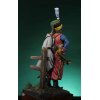Brand
Militia models
Stairs
54 mm.
Material
Resin
Sculpture
Massimo Ardissone
Box-Art
Andrea Terzolo
Product not suitable for children under 14 years - Kit not painted and not assembled
The Lithuanian Tatar cavalry unit of the Imperial Guard represents a fascinating aspect of the late Napoleonic age, even if placed in second order within the great panorama that general historiography has drawn and handed down to posterity. Formed between the height of Napoleon's military rise and his decline, this small unit acquired its own peculiar and legendary identity, starting with that disastrous Russian Campaign which represented the turning point of imperial greatness. Created in 1812 after the start of the campaign, the Lithuanian Tatars formed a cavalry squadron assigned to the lancer regiments of the Imperial Guard. Heavily involved in clashes with the Russians, the squadron emerged half-destroyed from the campaign but was subsequently reorganized and integrated into the Polish lancer regiment, being used alongside them during the German campaign of 1813 and the campaign in north-eastern France in 1814, at the end of which the unit was definitively disbanded.
In June 1812 Michel Sokolnicki , general of the Duchy of Warsaw attached to the French general staff, suggested to Napoleon the idea of creating a regiment among the Tatar populations living in the territories of the dissolved Grand Duchy of Lithuania, underlining «their probity, as well as their courage…". In September 1812, Count Van Hogendorp , the Emperor's aide-de-camp, informed the latter of an interesting possibility that had emerged following a conversation he had recently held with Major Mustapha Mura Achmatowicz . (extracted from the guide sheets contained in the assembly kit)










